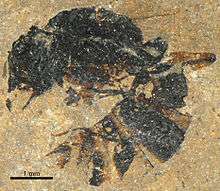Pachycondyla
Pachycondyla is a ponerine genus of ants found in the Neotropics.
| Pachycondyla | |
|---|---|
 | |
| P. harpax worker | |
| Scientific classification | |
| Kingdom: | Animalia |
| Phylum: | Arthropoda |
| Class: | Insecta |
| Order: | Hymenoptera |
| Family: | Formicidae |
| Tribe: | Ponerini |
| Genus: | Pachycondyla Smith, 1858 |
| Type species | |
| Formica crassinoda Latreille, 1802 | |
| Diversity[1] | |
| 37 species | |
Distribution
Pachycondyla is currently distributed from southern United States to northern Argentina,[1] but some fossil species (e.g. P. eocenica and P. lutzi) are found in Europe.
Species
The genus formerly contained hundreds of species, most of them belonging to at the time junior synonyms of Pachycondyla. While revising the ponerines, Schmidt & Shattuck (2014) revived many of the former synonyms, leaving only eleven species in Pachycondyla. They were not able to place some species with certainty, and left more than twenty species incertae sedis in Pachycondyla, acknowledging that "this placement is undoubtedly incorrect".[1]
- Pachycondyla constricticeps Mackay & Mackay, 2010
- Pachycondyla crassinoda (Latreille, 1802)
- Pachycondyla fuscoatra (Roger, 1861)
- Pachycondyla harpax (Fabricius, 1804)
- Pachycondyla impressa (Roger, 1861)
- Pachycondyla inca Emery, 1901
- Pachycondyla lattkei Mackay & Mackay, 2010
- Pachycondyla lenis Kempf, 1961
- Pachycondyla lenkoi Kempf, 1962
- Pachycondyla purpurascens Forel, 1899
- Pachycondyla striata Smith, F., 1858
incertae sedis

P. eocenica holotype
- Pachycondyla curiosa Mackay & Mackay, 2010
- Pachycondyla jonesii Forel, 1891
- Pachycondyla solitaria Smith, F., 1860
- Pachycondyla unicolor Smith, F., 1860
- Pachycondyla vidua Smith, F., 1857
- Pachycondyla vieirai Mackay & Mackay, 2010
- †Pachycondyla aberrans Dlussky, Rasnitsyn, & Perfilieva, 2015[2]
- †Pachycondyla baltica Dlussky, 2002
- †Pachycondyla calcarea (Théobald, 1937)
- †Pachycondyla conservata Dlussky, 2009
- †Pachycondyla crawleyi (Donisthorpe, 1920)
- †Pachycondyla dubia (Théobald, 1937)
- †Pachycondyla eocenica Dlussky & Wedmann, 2012
- †Pachycondyla globiventris (Théobald, 1937)
- †Pachycondyla gracilicornis (Mayr, 1868)
- †Pachycondyla labandeirai (Dlussky & Rasnitsyn, 2002)
 P. parvula holotype
P. parvula holotype - †Pachycondyla lutzi Dlussky & Wedmann, 2012
- †Pachycondyla? messeliana Dlussky & Wedmann, 2012
- †Pachycondyla minutansata (Zhang, 1989)
- †Pachycondyla nubeculata (Zhang, 1989)
- †Pachycondyla oligocenica Dlussky, Rasnitsyn, & Perfilieva, 2015[2]
- †Pachycondyla parvula Dlussky, Rasnitsyn, & Perfilieva, 2015[2]
- †Pachycondyla petiolosa Dlussky & Wedmann, 2012
- †Pachycondyla petrosa Dlussky & Wedmann, 2012
- †Pachycondyla succinea (Mayr, 1868)
- †Pachycondyla tristis (Dlussky, 2009)
References
- Schmidt, C. A.; Shattuck, S. O. (2014). "The Higher Classification of the Ant Subfamily Ponerinae (Hymenoptera: Formicidae), with a Review of Ponerine Ecology and Behavior". Zootaxa. 3817 (1): 1–242. doi:10.11646/zootaxa.3817.1.1. PMID 24943802.
- Dlussky, G. M.; Rasnitsyn, A. P.; Perfilieva, K. S. (2015). "The ants (Hymenoptera: Formicidae) of Bol'shaya Svetlovodnaya (late Eocene of Sikhote-Alin, Russian far east)". Caucasian Entomological Bulletin. 11 (1): 131–152.
External links


This article is issued from Wikipedia. The text is licensed under Creative Commons - Attribution - Sharealike. Additional terms may apply for the media files.
